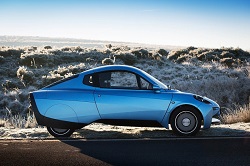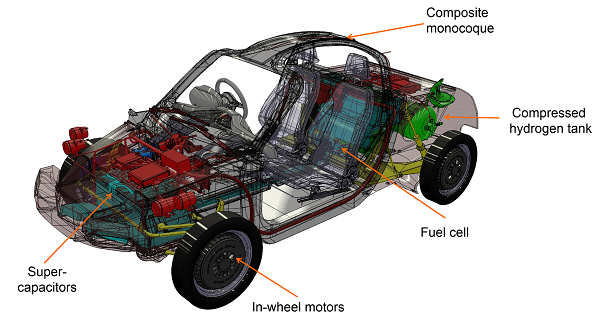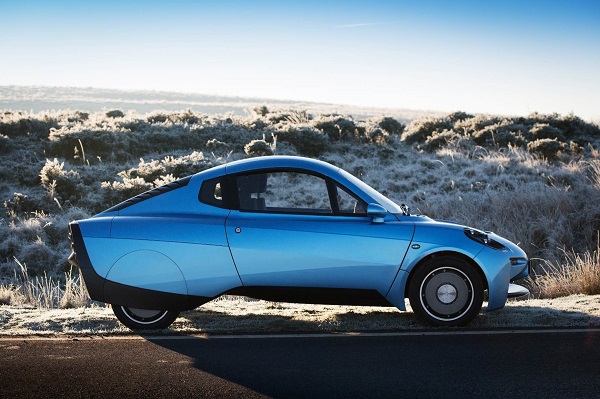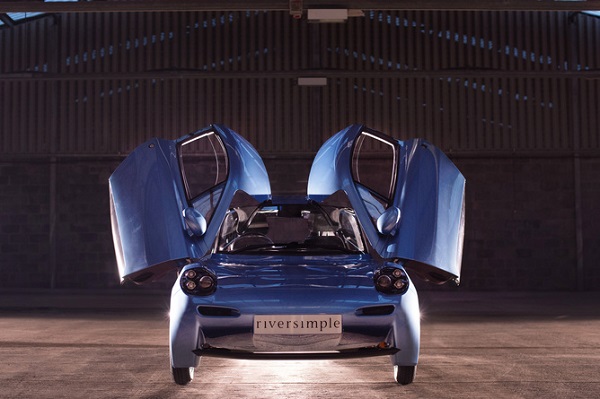
Welch company Riversimple is developing a hydrogen car, the Rasa, as in tabula rasa, which means clean slate. Rather than a design which modifies the basic layout of the internal combustion car, Rasa has a powertrain designed from scratch.
It’s certainly light, economical, and has a small carbon footprint. It may have a role in personal transport around cities, especially when cars become self-driving.
Starting from the business end, each wheel has an electric motor which draws from a “sort of high-tech electricity trap called a supercapacitor” (from New Scientist – paywalled). The Rasa supercapacitor can put out enough power to accelerate to 89 km/h in around nine seconds (from Gizmag).
The main source of power input to the supecapacitor is a steady trickle from the hydrogen fuel cell in the boot. An additional source comes from braking, which is effected by:
- reversing the motor in each wheel. This turns the motors into generators, recapturing the car’s kinetic energy and pushing it into the supercapacitor. Friction-based brakes only come into play for emergency stops.
About 50% of the kinetic energy from braking is captured this way.
Top speed is 96 km/h, but I’m not sure how long this can be sustained.
Of course the hydrogen has to be manufactured. If made from natural gas the so-called “well-to-wheel” emissions come in at around around 40 grams of CO2 per kilometre. The claimed fuel economy equivalent is 250 mpg or 0.9 L/100km, with the car able to travel 483 km (300 miles) on just one 1.5 kg (3.3 lb) tank of hydrogen. Of course you’d have to swap tanks before it was empty, as there is no backup system.
The body is made from a lightweight carbon-fibre monocoque shell, and with the use of aluminium the total kerb weight is just 580 kg (1,278 lb), compared with the original Lotus Elise at 770 kg, or the first generation Smart at 752 kg, also two-seaters. From Gizmag, here’s the layout:

It occurs to me that there is very little space for luggage, or even shopping. No doubt this will be fixed in the production version. Meanwhile this is what it looks like:

Here’s how the doors open:

Rasa will be shown in the London Motor Show in May. A 12-month trial with 20 cars is then planned, with a production model available in 2018. The car will only be leased, not sold. The lease will be in terms of a transport service, rather than a specific car, so repairs and eventual replacement are part of the deal.
It appears to me that the makers are targeting a specific niche market for personal movement around cities. Much will depend on price.
Gizmag says that the performance compares unfavourably with the Audi h-tron, which accelerates 0-100 km/h (0-62 mph) in under seven seconds, or the Honda Clarity, which has five seats, luggage space, a 700 km range and looks very much like a normal car.
Riversimple has it own site. Here’s a blog post that explains their supercapacitor. They anticipate that “the commercial Rasa will be more than 3 times as efficient as other fuel cell cars currently on the market.”
Paul Nieuwenhuis from Cardiff University looks at the Rasa, including the dispersed manufacturing model.

Why the hell would you want to build a hydrogen car that runs on hydrogen produced from natural gas? A car that depends on creating a hydrogen network and, and…..
Even if the hydrogen came from electrolysis of water using clean electricity it doesn’t make sense.
Parts of the concept may be useful but????
Riversimple is a startup company with a government grant. They must have put up a corporate plan that makes some sort of sense, one would think, unless the Welsh government has money to throw away.
They are claiming a carbon footprint that is competitive with existing technology. I’d agree that they’d have to move away from natural gas to a clean hydrogen production process in the course of time. Meanwhile I’d reckon price is crucial. I lack the necessary expertise, but I’d be surprised if it comes in cheap.
They are setting up refueling stations for the 20 pilot users. We’ll just have to see how it all works out.
Brian: As you know my bias is towards converting renewable hydrogen into an easily handable fuels such as liquid ammonia, methanol or fuels such as diesel, jet A etc.
Hydrogen is very difficult to safely transport and store.
John D: Tend to agree with what you say here – but this is a concept car, isn’t it?
Hydrogen is great for lifting – but I have my doubts about all the benefits claimed for its use for driving wheels.
Besides, how does the Rasa stack up against solar powered vehicles?
Graham, not sure of the definitions, but I don’t think the RASA qualifies as a ‘concept car’. The company is a startup and it’s planned as a production model.
I googled ‘Volkswagen concept cars’, and find they have 15 of them.
I didn’t post about it because I thought it was a good idea, simply because it was there, and it turns out it’s not the only hydrogen car on the planet.